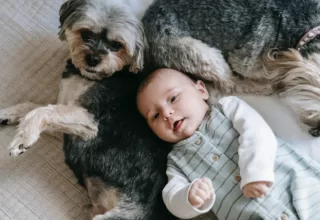When is it Safe to Introduce My New-born Baby to Our Pet?
Congratulations on the arrival of your newborn baby! As a pet owner, you may be wondering when it’s safe to introduce your new bundle of joy to your furry friend. Introducing a baby to a pet requires careful consideration and preparation to ensure the safety and well-being of both the baby and the pet. In this article, we will discuss important factors to consider when introducing your newborn baby to your pet, ensuring a harmonious and safe environment for everyone involved.
Introduction
Welcoming a baby into a home with a pet can be a heartwarming experience, fostering companionship and a lifelong bond. However, it’s crucial to approach the introduction with caution to avoid potential risks or stressful situations. By following a few essential guidelines, you can create a smooth transition and build a strong foundation for a loving relationship between your pet and your newborn.
Understanding the Importance of Pet Introduction
Introducing your newborn to your pet is essential for several reasons. It allows your pet to adapt to the new family dynamics and reduces the chances of jealousy or anxiety. Additionally, early exposure to a pet can have numerous benefits for your baby, including improved immune system development and social skills.
Assessing the Pet’s Behavior and Temperament
Before bringing your baby home, it’s crucial to assess your pet’s behavior and temperament. Some pets may have a calm and gentle nature, while others may be more excitable or easily agitated. Understanding your pet’s personality will help you determine the best approach for introducing your baby.
Preparing Your Home for Pet and Baby Interaction
Creating a safe and comfortable environment is vital for successful pet and baby interaction. Start by baby-proofing your home and ensuring your pet has a designated space that allows them to retreat when needed. Install baby gates to separate areas if necessary and remove any potential hazards or toxic substances that could pose a threat to your baby or pet.
Gradual Introduction and Supervision
When it’s time to introduce your baby to your pet, take a gradual approach. Begin by allowing your pet to sniff and investigate the baby’s belongings, such as blankets or clothes, to familiarize them with the scent. Always supervise their initial interactions and never leave your baby alone with the pet, even if your pet has shown no signs of aggression in the past.
Promoting Positive Interactions
To create a positive association between your pet and your baby, offer rewards or treats to your pet during supervised interactions. Use gentle, reassuring words and praise both your pet and your baby when they display calm and appropriate behavior. This positive reinforcement will help your pet understand that the baby is a welcomed member of the family.
Creating Safe Spaces
Both your pet and your baby need their own safe spaces within your home. Set up a cozy, quiet area where your pet can retreat when they need a break from the baby’s presence. Similarly, ensure your baby has a secure space, such as a crib or playpen, where they can play without the risk of unwanted pet interactions.
Hygiene and Safety Considerations
Maintaining proper hygiene is crucial when introducing your baby to your pet. Wash your hands thoroughly after handling your pet and before touching your baby. Keep your pet’s living area clean and free from any waste or potential sources of contamination. Regularly groom your pet to minimize shedding and allergens in the environment.
Maintaining Boundaries and Discipline
Establishing clear boundaries and consistent discipline is essential for both your pet and your baby’s safety. Teach your pet to respect the baby’s space and discourage any rough play or jumping near the baby. Use positive reinforcement training methods to reinforce desired behaviors and redirect any inappropriate behavior.
Monitoring and Gradual Increase in Interaction
As your baby grows, you can gradually increase the level of interaction between your baby and your pet. Encourage supervised playtime and gentle touch between them. Observe both your pet and your baby’s reactions during these interactions, ensuring they are comfortable and enjoying each other’s company.
Recognizing Warning Signs
It’s important to be aware of warning signs that indicate your pet may be uncomfortable or stressed around the baby. Signs of distress can include growling, hissing, raised fur, or attempts to hide or escape. If you notice these behaviors, separate your pet from the baby and consult with a professional trainer or behaviorist for guidance.
Conclusion
Introducing your newborn baby to your pet can be a joyous and rewarding experience when approached with care and consideration. By following the guidelines discussed in this article, you can create a safe and loving environment where your baby and pet can forge a lifelong bond. Remember to prioritize supervision, gradual introductions, positive reinforcement, and the well-being of both your baby and your pet throughout the process.
FAQs
Q: Can I introduce my newborn baby to any type of pet?
Yes, with proper precautions and supervision, you can introduce your newborn to various types of pets. However, some pets may require additional training or adjustments to ensure a safe and harmonious environment.
Q: Is it safe to have a pet around my newborn if I have allergies?
If you or your baby have allergies, it’s important to consult with a healthcare professional to assess the risks and discuss appropriate measures to manage allergies while still enjoying the benefits of pet companionship.
Q: What should I do if my pet shows signs of aggression toward my baby?
If your pet displays aggression toward your baby, it’s crucial to prioritize safety and seek professional assistance immediately. Consult with a veterinarian or a qualified animal behaviorist to address the issue and implement appropriate training and behavior modification techniques.
Q: How can I help my pet adjust to the new routine with a baby?
Maintain your pet’s routine as much as possible, providing them with regular exercise, mental stimulation, and attention. Gradually incorporate the baby into their routine, allowing them to adjust at their own pace.
Q: When can my baby and pet interact without constant supervision?
The age at which your baby and pet can interact without constant supervision depends on various factors, including the pet’s temperament, the baby’s development, and individual circumstances. It’s crucial to observe their interactions carefully and gradually increase independence based on their behavior and comfort levels.
How useful was this post?
Click on a star to rate it!
Average rating 0 / 5. Vote count: 0
No votes so far! Be the first to rate this post.



